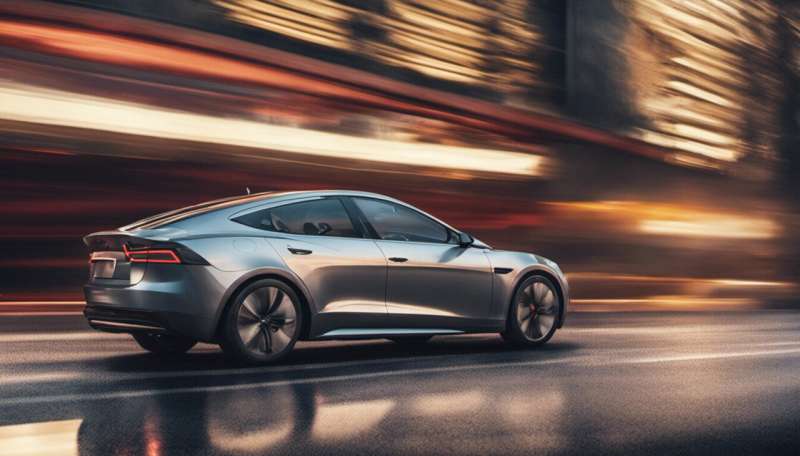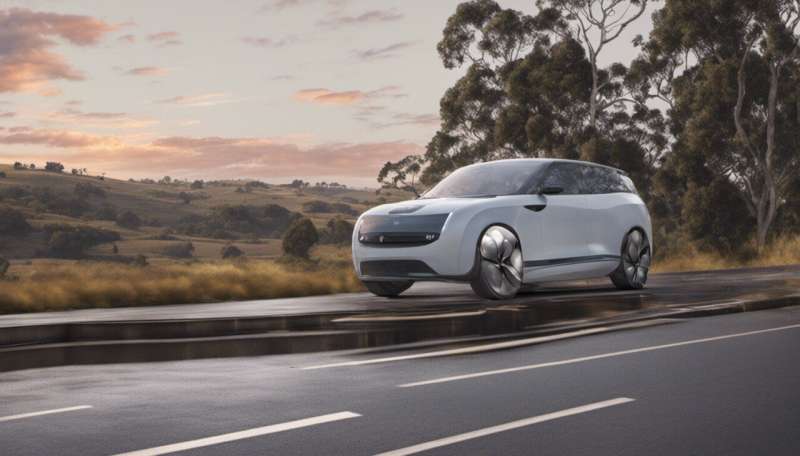On an electric car road trip around NSW, we found range anxiety (and the need for more chargers) is real

Replacing cars that run on fossil fuels with electric cars will be important in meeting climate goals—road transport produces more than 20% of global greenhouse gas emissions. But there are obstacles to wider uptake, particularly in Australia.
Too much of the debate about these vehicles revolves around abstract, technical calculations and assumptions about cost and benefit. Tariffs, taxes and incentives are important in shaping decisions, but the user experience is often overlooked. To better understand this we took a Tesla on a road trip from Sydney through some regional towns in New South Wales.
We soon found "range anxiety" is real. That's the worry that the battery will run out of power before reaching the destination or a charging point. It's often cited as the most important reason for reluctance to buy an electric vehicle.
Even as prices come down and hire and share options become more widespread, range anxiety about electric vehicles is hindering their wider uptake. We found it can largely be overcome through a range of strategies readily available now.
Lessons from our road trip
The first is simply to accumulate driving experience with a particular vehicle. Teslas promise a far simpler machine with fewer moving parts, but also incredibly sophisticated sensing and computational technology to help control your trip. This means you need to get a feel for the algorithms that calculate route and range.
These algorithms are black boxes—their calculations are invisible to users, only appearing as outputs like range calculations. On our trip, range forecasts were surprisingly inaccurate for crossing the Great Dividing Range, for example.
Second, we found it very helpful to connect with other electric vehicle users and share experiences of driving. Just like any new technology, forming a community of users is a good way to gain an understanding of the vehicle's uses and limits. Owner associations and lively online groups such as Electric Vehicles for Australia make finding fellow enthusiasts easy.
This connection can also help with the third strategy. It involves developing an understanding of how companies like Tesla control their vehicles and issue "over the air" software updates. If these specify different parameters for acceptable battery charge, that can change the vehicle's range.
Public investment in charging network will help
Public investment in charging infrastructure could—and should—further ease range anxiety. Better planning and co-ordination are needed, too, to build on networks like the NRMA's regional network of 50 kilowatt chargers.
Understanding what is involved for users is also crucial to the environmental benefits of electric vehicles. Their sustainability isn't just a function of taxes and technologies. The practices of people driving electric cars matter too.
You learn with experience what efficient driving requires of you. You can also work out how your charging patterns could match solar generation at home, for those lucky enough to have rooftop PV panels.
These vehicles can deliver significant environmental benefits. They produce zero tailpipe emissions, reducing both local air pollution and global greenhouse gas emissions.
Regenerative braking also reduces brake particulate emissions. That's because the electric motor operating in reverse can slow the car while recharging its battery.

Electric vehicles won't cure all ills
Switching from internal combustion to electric cars won't address all the problems of our current car-based system. Some, such as road congestion, could get worse.
Road traffic will still cause deaths and injuries. Electric vehicles will still produce deadly PM2.5 particulates as long as they use conventional brakes and tyres. Many models do, providing similar driving experiences to combustion vehicles.
Congestion and the costs of providing and maintaining roads, parking and associated infrastructure will still create enormous social, economic and environmental burdens. Electric vehicles need to be part of a much wider transformation—especially in urban areas where other transport options are available.
Rural and regional Australia can benefit too
Longer distances and lower densities make walking, cycling and public transport more challenging in rural and regional areas. Better support for electric vehicles, particularly chargers, could make a significant difference here.
These vehicles can help rural and regional areas in other ways too. Many holiday towns rely on tourist incomes but their electricity supply is at the mercy of long thin power lines that run through bushland. Electric vehicles could potentially help with this problem: when parked they can feed power back into the grid.
Regional economic planning that supports visits by electric vehicle drivers can reduce the need to invest in energy generation or battery systems. There are huge opportunities to integrate electricity planning and the (re)building of bushfire-affected towns, which a trial in Mallacoota will explore.
Pooled together, the batteries of an all-electric national vehicle fleet could provide power equivalent to that of five Snowy 2.0s. This would boost energy security and flexibility.
In the US, President Joe Biden has announced electric vehicles will replace the entire federal fleet of 645,000 vehicles. An extra 500,000 public charging stations are to be built within a decade.
In Australia, the policy landscape is more [contested]. It's time we caught up here.
We can start by recognising the importance of governments in the progress made internationally. Examples include the US$465 million US government loan to Tesla in 2009 to develop the landmark Model S, and Norway's co-ordinated national approach to properly accounting for the environmental and social costs of cars. Norway's success is now the focus of a laugh-out-loud Superbowl ad from GM, a company that in the past killed the electric car.
We need to understand users and have democratic debates about planning for charging infrastructure before we can sit back and enjoy the ride.
This article is republished from The Conversation under a Creative Commons license. Read the original article.![]()




















